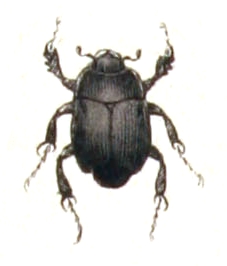
Hypocaccus is a genus of clown beetles in the family Histeridae. There are more than 120 described species in Hypocaccus.
Eremosaprinus hubbardi is a species of clown beetle in the family Histeridae. It is found in North America.
Eremosaprinus is a genus of clown beetles in the family Histeridae. There are about 10 described species in Eremosaprinus.

Plegaderus is a genus of clown beetles in the family Histeridae. There are more than 30 described species in Plegaderus.
Arizonacritus is a genus of clown beetles in the family Histeridae. There is one described species in Arizonacritus, A. talayesvai.
Teretriosoma is a genus of clown beetles in the family Histeridae. There are about 11 described species in Teretriosoma.
Strigister is a genus of clown beetles in the family Histeridae. There are at least two described species in Strigister.
Chelyoxenus is a genus of clown beetles in the family Histeridae. There are at least three described species in Chelyoxenus.

Tribalinae is a subfamily of clown beetles in the family Histeridae. There are about 11 genera and more than 220 described species in Tribalinae.
Pinaxister is a genus of clown beetles in the family Histeridae. There are at least four described species in Pinaxister.
Reninus is a genus of clown beetles in the family Histeridae. There are about 13 described species in Reninus.
Iliotona is a genus of clown beetles in the family Histeridae. There are about five described species in Iliotona.
Caerosternus is a genus of clown beetles in the family Histeridae. There is one described species in Caerosternus, C. americanus.
Eurylister is a genus of clown beetles in the family Histeridae. There are more than 40 described species in Eurylister.

Dendrophilus is a genus of clown beetles in the family Histeridae. There are about 10 described species in Dendrophilus.
Hippeutister is a genus of clown beetles in the family Histeridae. There are about six described species in Hippeutister.
Aritaerius is a genus of clown beetles in the family Histeridae. There is one described species in Aritaerius, A. pallidus.
Yarmister is a genus of clown beetles in the family Histeridae. There are at least two described species in Yarmister.
Geocolus is a genus of clown beetles in the family Histeridae. There is one described species in Geocolus, G. caecus.
Renclasea is a genus of clown beetles in the family Histeridae. There are about six described species in Renclasea.



